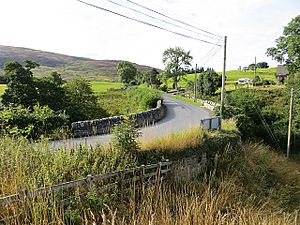Tinnis Castle (Yarrow) facts for kids
Tinnis Castle, also known as Tynnis Castle, was an old Scottish castle. It was a type of strong building called a tower house. This castle stood in a place called Old Tinnis, in the Scottish Borders. There was also another castle named Tinnis in a different area called Drumelzier.
Tinnis Castle in Yarrow was special because its lands were part of the "dower lands" for Scottish queens. This meant the queens received income from these lands. In the 1400s, the castle was used by the main royal official in charge of the Ettrick Forest, known as the Ranger or Master Currour of Yarrow.
A Royal Connection
A very old document, called a property charter, shows that there was a tower at Tinnis. Ruins of another tower can still be seen nearby at Deuchar. In December 1520, Margaret Tudor was the widow of King James IV of Scotland. She later married the Earl of Angus. Margaret Tudor gave the lands and tower of Tinnis to Lady Agnes Stewart, Countess of Bothwell, for nine years.
The lands of Tinnis in Ettrick continued to provide money for later Scottish queens, including Mary, Queen of Scots. This shows how important these lands were to the royal family.
The Castle's Demolition
In July 1592, King James VI of Scotland gave a strong order. He told William Stewart of Traquair to destroy the "place and houssis of Tynneis." The King also ordered the destruction of Harden and Dryhope castles. This happened because James Stewart of Tinnis and Walter Scott of Harden had joined a rebellion. They supported Francis Stewart, 5th Earl of Bothwell in an event called the Raid of Falkland.
It is not fully clear if the order was for Tinnis Castle in Yarrow or the one in Drumelzier. However, the very next year, Lord Home sold Tinnis tower in Yarrow. He sold it to John Home, who worked for the King. John Home then sold the tower and its lands to James Pringle.
Where Was Tinnis Castle?
Old maps show the former site of "Tynneis" was located between the Yarrow Water and the Lewenshope Burn. Today, only ruins or the site of the castle remain.


